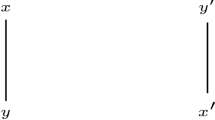Abstract
A fairly general definition of canonical solutions to algebraic systems over semirings is proposed. This is based on the notion of summation semirings, traditionally known as \({\Sigma }\)-semirings, and on assigning unambiguous context-free languages to variables of each system. The presented definition applies to all algebraic systems over continuous or complete semirings and to all proper algebraic systems over power series semirings, for which it coincides with the usual definitions of their canonical solutions. As such, it unifies the approaches to algebraic systems over semirings studied in literature. An equally general approach is adopted to study pushdown automata, for which equivalence with algebraic systems is proved. Finally, the Chomsky-Schützenberger theorem is generalised to the setting of summation semirings.
Similar content being viewed by others
Notes
To be more precise, weighted context-free grammars over complete semirings are considered in [6]. These can nevertheless be viewed as algebraic systems.
We shall dispense with a formally defined notion of weighted context-free grammars over semirings. Nevertheless, an idea of such grammars is useful for gaining intuition.
Semiring-polynomials can be introduced as a specialisation of the notion of polynomials over a universal algebra [16]. With this definition, a semiring-polynomial can be seen as a congruence class of a suitable congruence defined on the algebra of representations of semiring-polynomials as defined below. However, let us stress that this distinction is unimportant for our purposes, since similarly as in [9], we shall only be interested in mappings induced by (representations of) semiring-polynomials.
Note that the resulting algebra is not a semiring. On the other hand, the algebra of semiring-polynomials, which can be obtained as a factor algebra of the algebra of their representations, constitutes a semiring [16].
This generalised partition can be of any cardinality, as \((0 ~|~ i \in I^{\prime })\) is in \(\mathcal {F}\) for any \(I^{\prime }\).
More precisely, we should write \(m^{\prime } = \{c_{m,0}\} y_{1} \{c_{m,1}\} {\ldots } \{c_{m,r-1}\}y_{r} \{c_{m,r}\}\). However, we follow here the common practice of identifying a singleton set \(\{c\}\) with c itself.
The polynomials of a template system will in fact all be \(2_{1}^{\Sigma }\)-polynomials. However, the sets \(\emptyset \) and \(\{\varepsilon \}\) are the zero and the unity in the semiring \(2^{{\Sigma }^{*}}\), so they have to be included in order to satisfy the technical condition imposed in Definition 3.
Droste and Vogler [6] have in fact dealt with grammars over valuation monoids, thus going beyond semirings.
Here, N stands for a nonempty finite alphabet of nonterminals, \({\Sigma }\) stands for a nonempty finite alphabet of terminals, \(N \cap {\Sigma } = \emptyset \), \(P \subseteq N \times (N \cup T)^{*}\) is a set of production rules, and \(\sigma \) in N is the initial nonterminal.
For the sake of correctness, let us note that the following definition is sound only because it is consistent with the usual definition for automata over semirings of formal languages. This is a hidden proposition, which is nevertheless easy to prove.
References
Bloom, S.L., Ésik, Z., Kuich, W.: Partial conway and iteration semirings. Fundam. Inform. 86, 19–40 (2008)
Chomsky, N., Schützenberger, M.-P.: The algebraic theory of context-free languages. In: Braffort, P., Hirschberg, D. (eds.) Computer programming and formal systems, pp. 118-161. North Holland, Amsterdam (1963)
Davey, B.A., Priestley, H.A.: Introduction to lattices and order 2nd ed. Cambridge University Press, Cambridge (2002)
Droste, M., Kuich, W., Vogler, H.: Handbook of weighted automata. Springer, Berlin (2009)
Droste, M., Kuich, W.: Semirings and Formal Power Series. In: Droste, M., Kuich, W., Vogler, H. (eds.) Handbook of weighted automata. Monographs in theoretical computer science, pp 3–28. Springer, Berlin (2009)
Droste, M., Vogler, H.: The chomsky-schützenberger theorem for quantitative context-free languages. Int. J. Found. Comput. Sci. 25, 955–970 (2014)
Ésik, Z., Kuich, W.: A unifying kleene theorem for weighted finite automata. In: Calude, C. S., Rozenberg, G., Salomaa, A. (eds.) Maurer Festschrift. LNCS, vol. 6570, pp 76–89. Springer, Berlin Heidelberg (2011)
Ésik, Z., Kuich, W.: Inductive *-Semirings. Theor. Comput. Sci. 324, 3–33 (2004)
Ésik, Z., Kuich, W.: Modern automata theory. http://www.dmg.tuwien.ac.at/kuich/mat.pdf
Hebisch, U., Weinert, H.J.: Semirings – algebraic theory and applications in computer science. World Scientific, Singapore (1998)
Hopcroft, J.E., Ullman, J.D.: Introduction to automata theory, languages, and computation. Addison-Wesley, Reading (1979)
Korenjak, A.J., Hopcroft, J.E.: Simple deterministic languages. In: SWAT 1966, pp 36–46. IEEE Computer Society, Washington (1966)
Kostolányi, P., Rovan, B.: Automata with auxiliary weights. Int. J. Found. Comput. Sci. 27, 787–807 (2016)
Kuich, W.: Semirings and formal power series: their relevance to formal languages and automata. In: Rozenberg, G., Salomaa, A. (eds.) Handbook of formal languages, vol. 1, pp 609–677. Springer, Berlin (1997)
Kuich, W., Salomaa, A.: Semirings, automata, languages. Springer, Berlin (1986)
Lausch, H., Nöbauer, W.: Algebra of polynomials. North Holland, Amsterdam (1973)
Petre, I., Salomaa, A.: Algebraic systems and pushdown automata. In: Droste, M., Kuich, W., Vogler, H. (eds.) Handbook of weighted automata. Monographs in theoretical computer science, pp 257–289. Springer, Berlin (2009)
Sakarovitch, J.: Elements of automata theory. Cambridge University Press, Cambridge (2009)
Salomaa, A., Soittola, M.: Automata-theoretic aspects of formal power series. Springer, New York (1978)
Stanat, D.F.: A homomorphism theorem for weighted context-free grammars. J. Comput. Syst. Sci. 6, 217–232 (1972)
Author information
Authors and Affiliations
Corresponding author
Additional information
Publisher’s Note
Springer Nature remains neutral with regard to jurisdictional claims in published maps and institutional affiliations.
This work was supported by the grants VEGA 2/0165/16 and UK/176/2017.
Rights and permissions
About this article
Cite this article
Kostolányi, P. A Unifying Approach to Algebraic Systems Over Semirings. Theory Comput Syst 63, 615–633 (2019). https://doi.org/10.1007/s00224-018-9895-9
Published:
Issue Date:
DOI: https://doi.org/10.1007/s00224-018-9895-9



